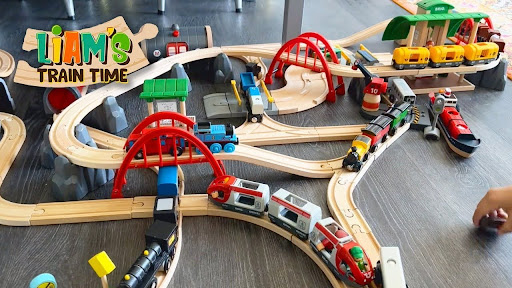Introduction
Toy railroading bridges generations, captivating children and rekindling nostalgia in adults. The gentle clatter of wheels on wooden tracks, the satisfying click of curved segments, and the freedom to redesign landscapes each afternoon make miniature railways versatile. Sweden’s BRIO, founded in 1884, embodies this magic through crafted wooden locomotives and modular track. For more than a century the company has adapted materials, safety standards, and play patterns while preserving the tactile charm that first won parents’ trust.
This article explores BRIO’s origins, design philosophy, educational value, environmental commitments, and future direction, mapping out why the brand remains a benchmark for responsible toy engineering.
Origins of a Wooden Classic
The first brio train set arrived in 1958, introducing hidden magnets that let children couple cars instantly and build networks without adult help. Before this innovation, most toy trains used metal hooks that demanded perfect alignment. BRIO’s magnetic connectors encouraged experimentation and reduced frustration, setting a new industry standard. The company’s story, however, began decades earlier in the forests of southern Sweden, where founder Ivar Bengtsson crafted wooden goods with meticulous care.
That heritage translated into toy locomotives milled from sustainably sourced beech, hand‑sanded and coated with food‑safe lacquer. From the outset every piece underwent strict inspection, establishing a quality benchmark competitors have chased ever since. Early catalogues highlighted the railway’s compatibility with wooden blocks, encouraging builders to integrate bridges into castles and cityscapes. By the late 1970s the brand had shipped to more than fifty countries, cementing its status as an international symbol of Scandinavian design excellence.
Design Principles: Safety Meets Imagination
BRIO’s design rests on three pillars: robustness, open‑endedness, and aesthetic restraint. Robustness starts with dense beech that resists dents when dropped from toddler height. Components exceed international choke‑tube measurements, and water‑based paints minimize volatile compounds. Open‑endedness appears in minimalist styling; an engine’s subtle smile or simple color stripe suggests personality yet leaves the storyline to the child.
Aesthetic restraint lets natural grain show through, reinforcing a connection to nature and avoiding garish novelty that dates quickly. Children naturally project emotions onto the wooden figures that accompany stations and freight yards, extending play into the social realm and subtly reinforcing empathy and cooperative problem‑solving in everyday scenarios. This harmony of safety, imagination, and timelessness explains why a track piece made fifty years ago still locks perfectly into one fresh from a modern toy shop.
Modular Track Systems and Expandability
Backward compatibility remains BRIO’s greatest engineering promise. Straight rails pressed in the 1960s join effortlessly with today’s plastic suspension bridges, letting grandparents share childhood pieces with grandchildren. This consistency turns each purchase into a long‑term investment rather than a passing craze. Standardized connectors invite exploration of curvature, gradient, and load distribution by simply rearranging track segments.
Special packs add switches, level crossings, and risers that elevate layouts, challenging builders to maintain momentum on an incline. Because parts are available individually and in themed bundles, families can expand gradually, keeping creativity front and center without overwhelming new users. Seasonal expansion packs—such as winter snow tunnels or seaside ferry docks—refresh layouts without forcing families to start over from scratch.
Educational Benefits: Foundation for STEM Learning
Educators describe BRIO layouts as portable physics labs. Children witness momentum as engines coast down slopes or stall on sharp turns, internalizing cause and effect. Math skills grow through counting sleepers, measuring bridge heights, and comparing loop circumferences. Spatial reasoning, linked to later success in engineering and coding, improves as young builders visualize routes before assembling them. Group projects nurture patience and communication; when a bridge collapses, peers negotiate solutions instead of assigning blame.
Many teachers now station small track sets in classroom centers, pairing storytelling cards with construction tasks to unify language and science in a single playful exercise. Survey data indicate that classrooms using wooden railways report measurable gains in cooperative behavior within just six weeks of implementation.
Sustainability and Scandinavian Craftsmanship
Environmental stewardship is integral to BRIO’s identity. Timber arrives only from Forest Stewardship Council–certified forests where systematic replanting offsets harvesting. Wood shavings fuel on‑site biomass boilers that dry future lumber, turning waste into energy. Packaging uses unbleached cardboard and vegetable inks, while petroleum plastics have been largely replaced by biodegradable cellulose film. The company even tracks transport emissions and offsets them through Scandinavian rewilding projects.
Parents seeking toys that align with sustainable values therefore find BRIO an easy choice, knowing their purchase supports responsible forestry and fair Nordic labor practices. Even end‑of‑life considerations are addressed: BRIO publishes disassembly guides so broken engines can be separated into wood, metal, and circuitry for proper recycling at home.
Embracing Technology Without Losing Tactility
Digital entertainment competes for attention, yet BRIO integrates technology without sacrificing tactility. Battery engines teach stored energy and circuitry, and sound modules add auditory feedback. Select locomotives now connect via Bluetooth, turning phones into remote throttles or scheduling tools. These electronics remain optional; the core experience is still a child pushing a train and feeling its weight along wooden rails.
This balanced strategy acknowledges ever‑present screens while defending the developmental power of hands‑on, self‑directed play, ensuring BRIO remains relevant for modern families. Future prototypes, currently in pilot testing, pair physical switches with app‑based logistics challenges, asking children to allocate virtual freight efficiently before executing the plan on a real track.
Conclusion
From its pioneering magnetic couplers to its rigorous eco‑policies, the brio train set shows how thoughtful design can evolve while honoring tradition. The system’s modularity feeds creativity, its safety credentials reassure parents, and its classroom presence validates educational worth. Amid a flood of disposable plastic gadgets, BRIO’s beechwood rails prove that durable, tactile play retains unique value. Whether circling a living‑room rug or rumbling across a preschool floor, each journey builds fine‑motor skills, narrative thinking, and confidence. In an era hungry for sustainable, meaningful toys, this humble wooden railway continues to inspire future engineers and storytellers alike. Such enduring versatility underscores why the set has earned museum recognition worldwide. Truly.











